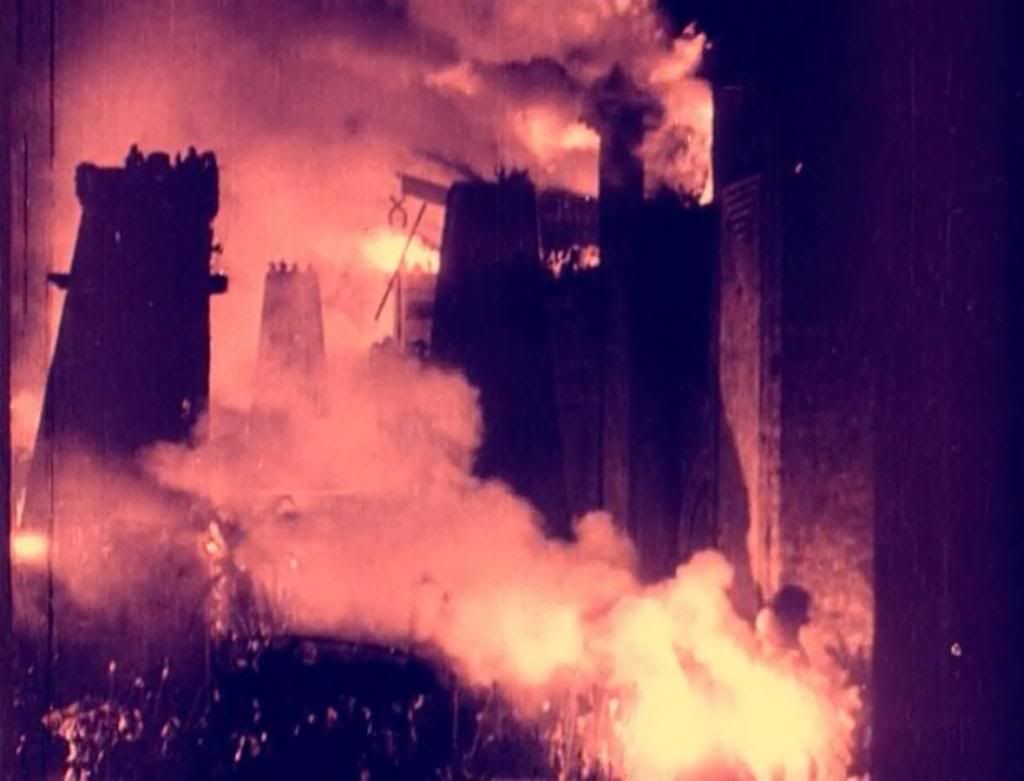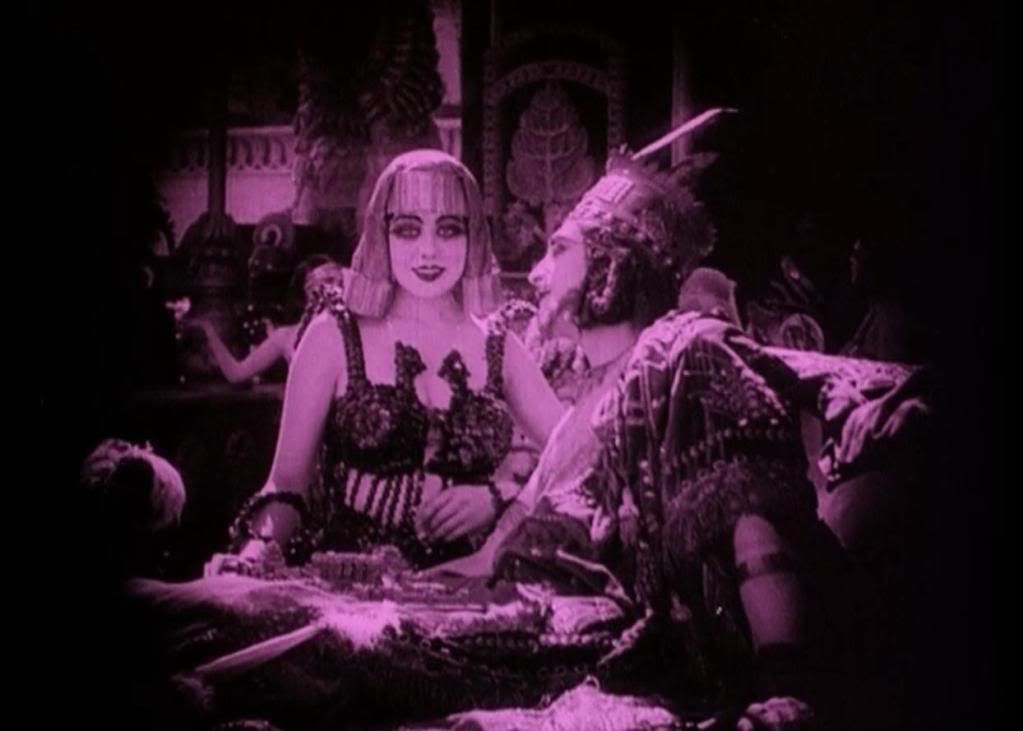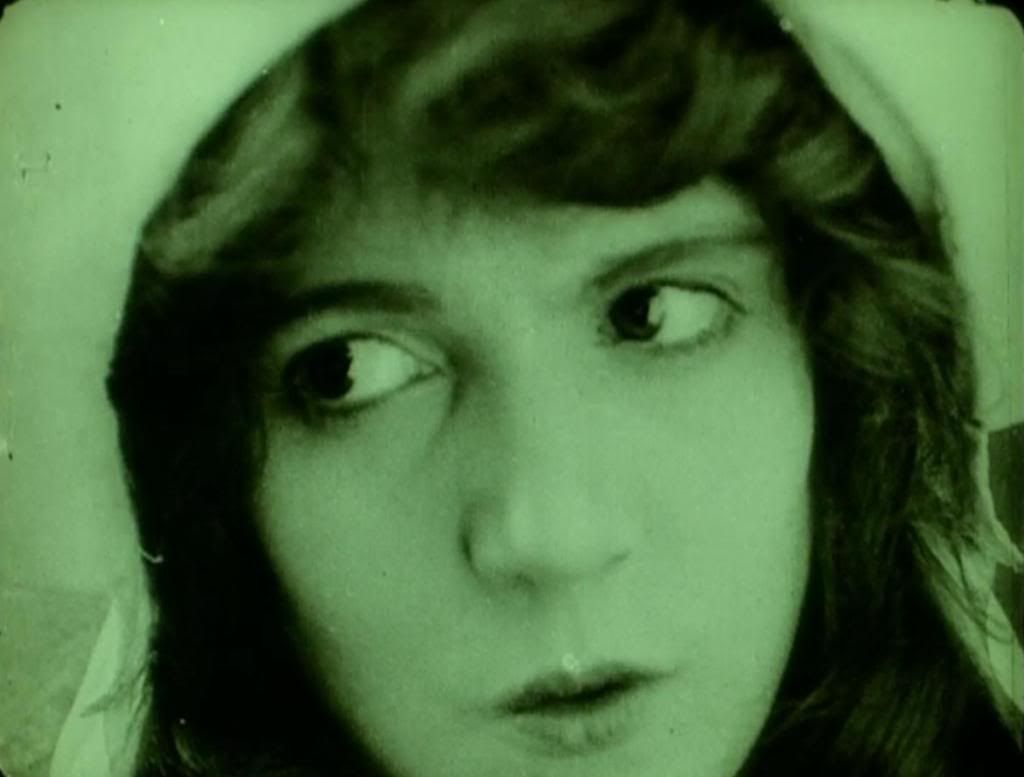
Boldly ambitious, staggeringly epic, and, for its time, remarkably experimental in its approach to narrative and themes, D.W. Griffith's Intolerance is justifiably a landmark of the silent cinema, perhaps even more so than its more famous (and infamous) predecessor in his oeuvre, The Birth of a Nation. This three-hour epic tells four stories set in four different eras, weaving the thematically related tales together throughout the film, cutting between eras to draw connections between them. In the most prominent story, set in the modern day, the lives of a young couple are torn apart by capitalist exploitation, self-righteous social reformers, and injustice. This intensely melodramatic romance is buttressed by three historical tales: the crucifixion of Jesus, the violence between Catholics and Huguenot Protestants in 1500s France, and the ancient war between Babylon and Persia, also rooted in religious strife. Of those three historical segments, only the Babylonian epic is really developed into its own story, nearly the equal of the modern story in terms of detail and screen time; the other two stories simply provide short sequences that serve as illustrations or parallels to the action in the modern and Babylonian stories.
The film's sweeping scope and ambition are as dazzling as they are exhausting. Griffith hammers home his simple themes relentlessly, and everything is broad and lurid, the emotions rendered with big, sloppy outbursts of feeling. The emotions range from innocent love to craven jealousy or pettiness, and there's no middle ground, only these extremes of intense emotionality, delivered with grand gestures and shameless mugging. The acting is locked into this heightened register, especially the cutesy, girlish overemoting of both Constance Talmadge as the Mountain Girl of the Babylonian story and Mae Marsh as the cloyingly named Dear One in the modern romance. (Although Talmadge does provide one of the film's most endearing little moments, in a throwaway sequence in which, playing with a goat, she bites the animal's ear.)
The Babylonian story fares best here, because it's naturally suited to the grandness and exaggeration that infuses the aesthetic and performative style dominating the movie. Everything about the Babylonian story is big and excessive, from its famous massive sets to its swarms of extras to its lavish feasts and battle scenes. The Babylonian story is an expression of pure sensual excess, filmed mostly in wide shots in which the frame seems to be packed with hordes of people, scurrying around the city like ants, dwarfed by the massive statues of rival gods and the towering walls of Babylon itself. The Mountain Girl's story exists at the fringes of the historical drama: her life is briefly touched by the Babylonian king Belshazzar (Alfred Paget), and she dedicates herself to him thereafter, doting on him from afar while he romances his beautiful Princess Beloved (Seena Owen) and wars with the advancing Persian armies. Whereas the modern story is a melodrama of individual romance and separation, the Babylonian part of the film is more abstract, its action occurring at a level where individuals are often mere specks in the corner of the frame. It's exhilarating and mad and frenzied, and packed with unforgettable images: most memorably, a tiny chariot pulled by white doves, carrying a flower between lovers, a concept that's poignant and hilarious at once.


Intolerance is kind of like that Alanis Morissette song about irony in which most of the verses aren't actually ironic; although Griffith keeps hammering home that his film is about the opposition between intolerance and love, most of the film's situations don't really chronicle intolerance as it's usually understood, so much as hypocrisy and injustice. At the core of the film is an opposition between carnality, physicality and freedom on the one hand, and repression, meddling and asceticism on the other. There's no question which side is favored by Griffith, who makes the film's celebrations of excess and bombast truly overwhelming — especially in the ecstatically sensual Babylonian thread, with its half-naked dancing girls and massive citywide parties — while viciously mocking the hypocritical champions of "reform" and restraint. Even Griffith's Jesus gets in on the act; it's no coincidence that Griffith makes sure to highlight, in his otherwise very abbreviated account of the New Testament, the miracle of turning water into wine, showing Jesus proudly presiding over a raucous party that can resume its boisterous course once the wine supply has been replenished.
Griffith makes the Pharisees' primary complaint about Jesus that he's "a winebibber" and a friend to lower-class rabble and sinners, thus paralleling the crusade against Jesus to the modern-day advocates of Prohibition, who ironically work in Jesus' name to prohibit fun and partying and pleasure. These no-fun old biddies are the real villains of the film, social reformers who are "intolerant" of anyone having fun. They're meddling hypocrites who use money taken from their connections with exploitative industrialist kingpins to restrict the activities of the very working class employees who are exploited by the reformers' capitalist supporters. There's also an obvious sexist undercurrent to Griffith's depiction of these crusaders, whose actions are explained in terms of their age and homeliness in a particularly egregious title card: "when women cease to attract men they often turn to Reform."
Beyond that nasty thread of sexism, there's an even more telling subtext to these denunciations of meddling reformers who couch their interference in terms of moral outrage. Griffith's previous feature, The Birth of a Nation, had been the subject of much protest and criticism for its infamously despicable depiction of black predation on white women and its lionization of the Ku Klux Klan. It's tempting to think that Griffith built his next film around the concept of "intolerance" by way of atonement, but the film itself is not an apology but an indignant rebuttal directed at the "intolerance" of his critics for the views expressed in his earlier film. Racial intolerance is not part of the brief here; rather, he's condemning the intolerance of those who try to reform society, imposing their ideas on others, and thus drawing parallels between social reformers decrying the treatment of blacks and those calling for the Prohibition of alcohol and other so-called social ills. At the heart of the film's concept of "tolerance" is the espousal of a live-and-let-live philosophy that's actually really objectionable when one realizes that Griffith seems to have in mind "tolerance" for bigots. Ironically, in Griffith's formulation, those protesting and pointing out intolerance are themselves the ones who are intolerant, presumably because they don't respect the ideas of bigots.

The film is curiously twisted in its themes and its subtexts, and when it's not offering backhanded stabs at the director's "intolerant" critics, it's delivering simplistic pleas to end all war and replace fighting with love. The film ends with a dazzlingly saccharine vision of a future without war, complete with heavenly hosts floating above a battlefield and a prison being replaced with a field of flowers. But if the film is ideologically suspect, historically inaccurate, and melodramatically overwrought, it's also undeniably exciting and finely crafted in terms of its aesthetics and the mechanical precision of Griffith's cross-cutting, here ratcheting up suspense and creating connections not just within the same story but between stories.
The apex of this approach is the thrilling climax, in which the Dear One's husband (Robert Harron), wrongly convicted of a crime, is set to be hanged. Griffith builds the suspense over the course of a solid half-hour, as the girl struggles to get the evidence to clear her man's name, then races to catch the governor, then races to the jail for a last-second rescue attempt. Griffith employs the signature cross-cutting that by this time he'd developed into a well-honed art, cutting between the condemned man's last rites and his long walk to the gallows, and the frantic activities of his wife as she pursues a train and speeds through the streets towards the jail. Griffith also elongates the suspenseful moment by cutting away to the other stories, in which there is no such suspense, but the predictably tragic climaxes of those tales — Babylon is sacked, Jesus is crucified, and the Catholics slaughter the Huguenots — provide a grim parallel to the likely outcome of the modern-day romance.
Griffith's command of cinematic language is what's most impressive today, looking beyond the film's many problems. The director's ability to use form to heighten the effect of narrative was unparalleled in the early cinema, particularly in his feel for grand action set pieces and endlessly building suspense. The Babylonian sequences also confirm the director's penchant for spectacle, with his camera sometimes even breaking free of the mostly static set-ups to drift gracefully closer to the action, tracking in from the epic wide shots to focus on some details within the sprawling chaos. It's no wonder that Erich von Stroheim, working as an assistant on the Babylonian parts of the film, was inspired by Griffith's dazzling spectacles. Intolerance as a whole is an uneven and contradictory experience, but the wild ambition and inventiveness of its director always show through, and partially redeem, even its worst failings.

3 comments:
Its failings are wedded to its successes in every way. Intolerance is a towering piece of cinematic insanity that simply must be seen to be disbelieved.The different storieis are supposed to be theatically connected but in dramatic terms they have nothing to do with one another and thus are arbitrarily wedded together in an act of pure surrealist inspiration.
Racial intolerance isn't included because Griffith being a Confederate supporter had no idea what it meant.
Hi Ed, I just wanted to let you know that I linked your excellent review of Intolerance in the LAMB's Classic Chops since I am now hosting this event. Your review push me to rewatch this amazing masterpiece thanks for sharing such accurate thoughts on it.
Hi, obviously you don't know me from DW Griffiths but I'm watching this right now and marvelling at its total tone-deafness to Intolerance (and wondering if I'll ever have the stomach to watch Birth of a Nation) and I found your essay here both critically on-point and ascerbically hilarious ("the cloyingly named Dear One") etc. You did however miss out the whole onion-eating scene which is my favorite Mountain Girl moment so far (though her ridiculous glee during the siege is also pretty funny). Anyway, bookmarking your blog to keep reading—it's just wonderful. Thank you.
Post a Comment